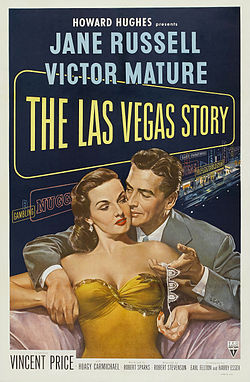Plot
Happy is the piano player at the "Last Chance Casino" in Las Vegas. He wonders what split up Linda Rollins and Dave Andrews. He muses: "Something quick and sudden must have happened to them".
Linda reluctantly returns to Las Vegas by train when her loser husband Lloyd Rollins insists on vacationing there. When the couple disembarks, fellow passenger Tom Hubler hurriedly does as well. Upon checking into the Fabulous Hotel & Casino, Rollins requests a line of credit and Linda discovers that her husband is in some kind of financial trouble, possibly criminal as well, and suspects he is trying to raise money by gambling. The first night, Rollins insists she wears her necklace, appraised at $150,000, when they go out.
Later, Linda encounters Dave, now a lieutenant with the sheriff's department, who is initially none too pleased to see her again. They heatedly discuss the ending of their relationship.
The next day, Hubler tries to become friendly with Linda at the hotel pool, but she brushes him off. Later, he tells Lloyd that he has been assigned by his insurance company to watch him and the necklace. Mr. Drucker, the Fabulous' Managing Director, eventually discovers Rollins is a fraud and tells him he is no longer welcome at the Fabulous.
Rollins obtains $10,000 in credit from Clayton, owner of the Last Chance casino, by putting up Linda's necklace as collateral, but he loses it all, gambling. He tries to get Clayton to advance him more credit, but Clayton turns him down, telling him he will sell the necklace back to him for the $10,000. Early the next morning, Clayton is found stabbed to death, and the necklace is missing. Dave assumes the murderer took the necklace.
Dave arrests Rollins. Rollins tries to get his wife to give him an alibi but she cannot, because she was with Dave at his home at the time.
With a suspect in custody, Hubler returns to the scene of the crime with Linda and has her reenact the steps she took the night before, thereby implicating himself. Dave figures out the real killer's identity when Happy tells Dave of Hubler's interactions with Linda. Dave realizes that Hubler slipped up and revealed the location of the stabbing. After the murderer left, the dying Clayton managed to crawl toward a telephone: Hubler did not know that.
Dave phones Linda to warn her, but Hubler, who has been after the necklace the whole time, kidnaps Linda. With roadblocks set up on all major highways and a description of his rented car being broadcast, he steals another car, killing the owner. Dave engages a helicopter and spots the speeding vehicle. He and the pilot manage to force Hubler to leave the car at an abandoned base. Hubler wounds the pilot and forces Dave to throw out his gun by threatening to kill Linda, but, after a chase and a fight, Dave is able to retrieve a gun and shoot Hubler dead.
Back in Las Vegas, Linda decides to break up with her husband and remain in Las Vegas. Lloyd, who has been cleared of the murder, is quickly re-arrested on embezzlement and other charges.
Reception
Box-office
The film lost an estimated $600,000. [9] [10] [11]
Critical response
Bosley Crowther, the film critic for The New York Times , gave the film a mixed review, writing, "The Las Vegas Story at the Paramount is one of those jukebox gambling films that gives the impression of being made up as it goes along ... For the simple fact is that Miss Russell is slightly grotesque to look upon in the tacky costumes and pinched-in get-ups with which she is cheaply adorned, and for the rest she contributes to the drama nothing more than a petulant pout and a twangy whine. But, then, the scriptwriters, Earl Felton and Harry Essex, have not made demands in their loose-jointed, tabloid-tinted fiction for more than the lady gives. And the rest of the cast does not embarrass her by playing above her head. The best to be said on behalf of this hit-or-miss R. K. O. film is that, in throwing side glances at the sap-traps of Las Vegas, it points its own indeterminate moral: patrons proceed at their own risk; the odds are in favor of the house." [12]
In their film review, Time Out magazine discussed the background of the studio that produced the film, writing, "A minor RKO gem showing all the preferences of its then owner Howard Hughes (aeroplanes, brunettes, breasts and disenchanted heroes)...It all finishes with a perfunctory nod toward family values (by marrying off an irrelevant young couple), but the film wears its intentions on its sleeve with the final shot: Hoagy looks first at the seductive Russell, then winks at us as he sings, My resistance is low ..." [13]
Film critic Dennis Schwartz liked the film and wrote, "Robert Stevenson (My Forbidden Past) walks out a winner in this pulpish crime drama that he directed with panache. It's mainly scripted by Paul Jarrico who received no screen credit because of his pro-communist sympathies that met with the disapproval of nutty right-wing RKO boss Howard Hughes, who decided to take on the powerful Screen Writers Guild. This prompted a civil suit by Jarrico, who later suffered from a blacklist by HUAC over his politics. Hughes lost $600,000 on this B-film gem, probably the best film he ever produced...The exciting climax has for the first time a car/helicopter chase sequence on film ... It ends with a playful Happy and a divorce-minded Linda working together again and singing a duette with lyrics such as "Keep your distance, my resistance is low", which might explain what this appealing oddball story was all about." [14]
RKO announced plans to reteam Mature and Russell in Split Second, [15] but neither ended up appearing in that film.
